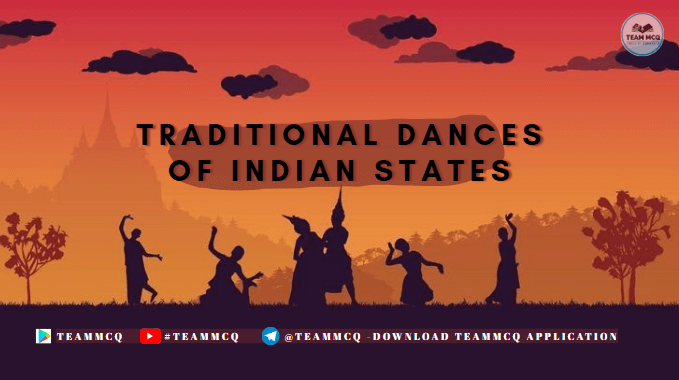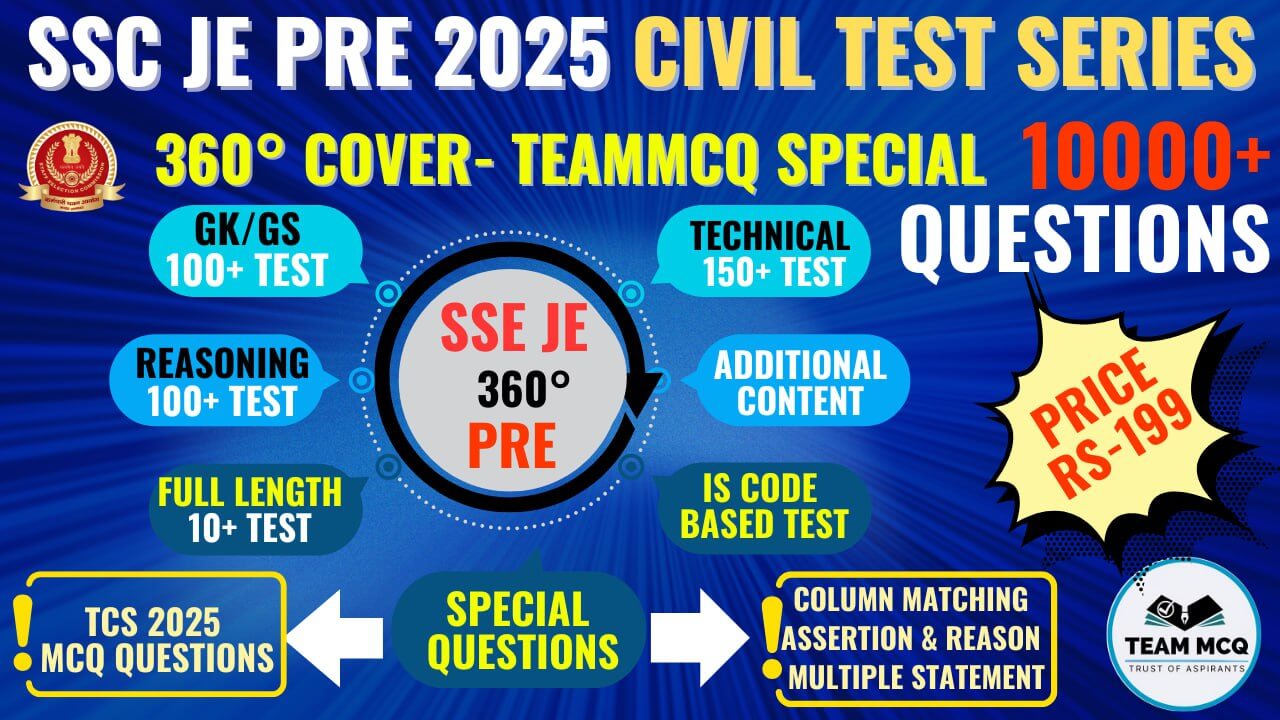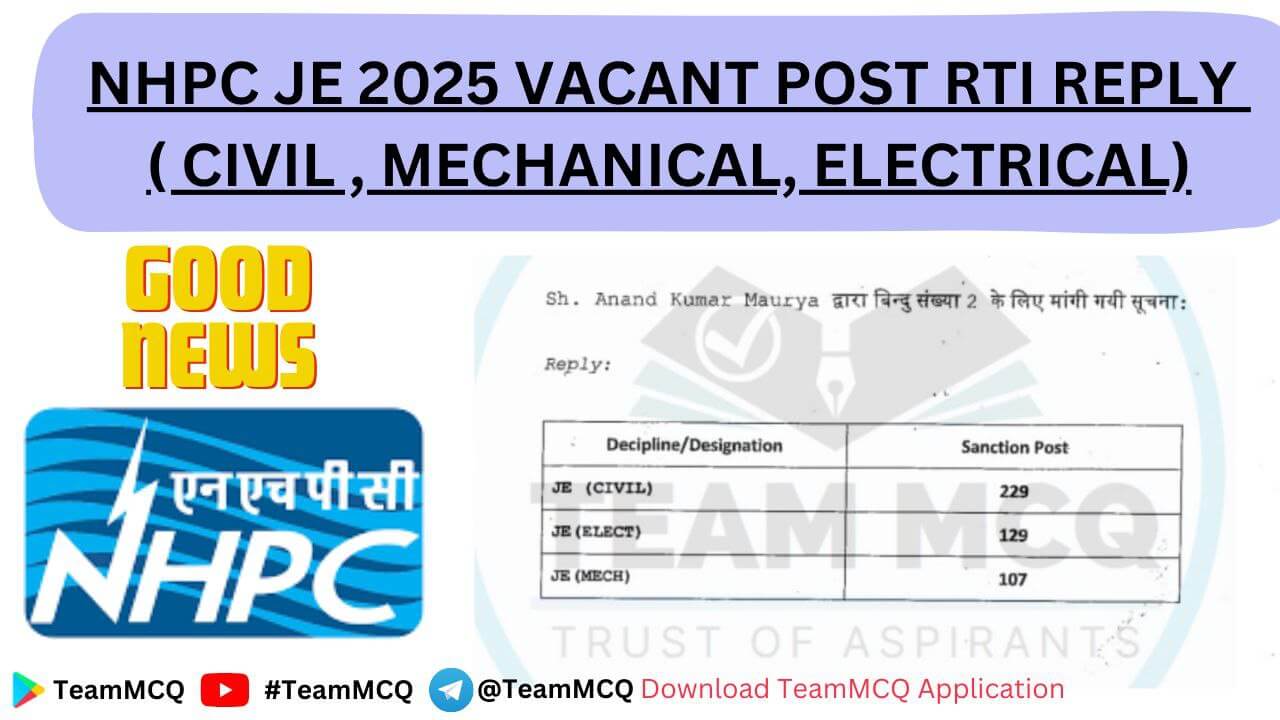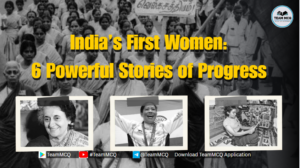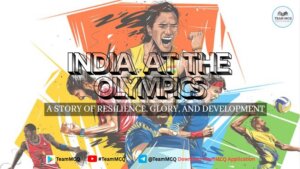Explore the vibrant traditional dances of Indian states — from Bharatanatyam to Bihu — and discover how each rhythm reflects India’s cultural heritage.
Introduction: Rhythms of Culture – A Journey Through Traditional Dances of Indian States
India’s cultural canvas is painted with rhythmic movements, vibrant costumes, and soul-stirring music. From the snow-capped Himalayas to the sandy shores of Tamil Nadu, traditional dances of Indian states echo centuries of stories, spirituality, and celebration. These dances are more than art—they are living legacies passed down through generations.
Whether it’s the classical grace of Bharatanatyam from Tamil Nadu, the high-energy Bhangra from Punjab, or the spiritual trance of Sattriya from Assam, each state expresses its identity through rhythm and motion. The traditional dances of Indian states often trace their roots to ancient temples, harvest rituals, or royal courts, and many are still performed during festivals, weddings, and sacred ceremonies.
In a time when global influences dominate entertainment, these native art forms remind us of our roots. They reflect regional beliefs, folklore, and social customs, making each dance form a cultural ambassador in its own right.
In this article, we explore the traditional dances of Indian states, understanding their origins, styles, and significance in shaping India’s rich cultural heritage. Get ready to witness India’s heartbeat—one step at a time.
Tamil Nadu – Bharatanatyam & Karagattam
Tamil Nadu, a cultural jewel of South India, is renowned for its vibrant temple traditions, devotional art forms, and deep-rooted spirituality. The traditional dances of Indian states often reflect their cultural ethos, and in Tamil Nadu, this is beautifully seen in Bharatanatyam and Karagattam.
Bharatanatyam, one of the oldest classical dances of India, originated in the temples of Tamil Nadu as a form of devotional expression. Characterized by precise hand gestures (mudras), expressive facial movements, and intricate footwork, it is traditionally performed by women in ornate costumes and jewelry. The dance narrates mythological stories and is accompanied by Carnatic music and instruments like the mridangam and nattuvangam.

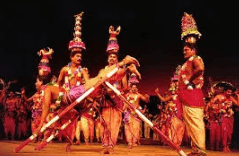
On the folk side, Karagattam is a joyful dance performed during village festivals. Dancers balance pots (karagams) on their heads while performing agile moves to folk beats. It’s often dedicated to the rain goddess Mariamman, symbolizing devotion and community celebration.
These traditional dances of Indian states are still alive today through cultural academies, state-sponsored festivals, and international showcases. Schools across Tamil Nadu actively promote them, making sure the rhythms of the past continue to echo through the future.
Punjab – Bhangra & Giddha
The land of five rivers, Punjab bursts with infectious energy, and its dances are no exception. Among the traditional dances of Indian states, Bhangra and Giddha are synonymous with joy, celebration, and the resilient Punjabi spirit.
Bhangra evolved from harvest celebrations and is now performed at weddings, festivals, and even global stages. With vigorous movements, jumps, and beats of the dhol, this dance is typically performed by men wearing vibrant turbans and kurtas.
Giddha, the female counterpart, is equally energetic but more expressive. Women form circles, clapping rhythmically, and perform short verses called boliyan that humorously reflect daily life, relationships, and social themes.
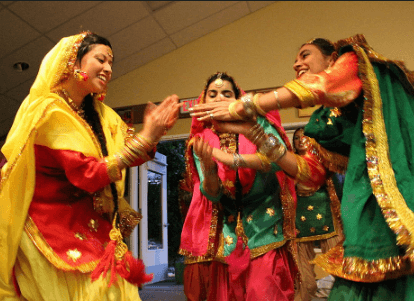
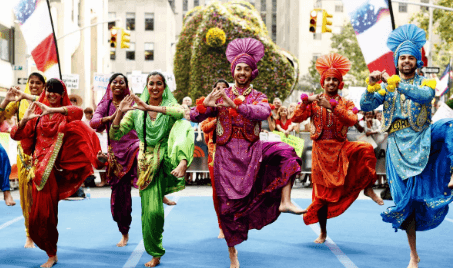
Both dances are staples of Punjabi festivals like Vaisakhi and Lohri. Today, they feature prominently in national and international cultural events, helping preserve the traditional dances of Indian states in a rapidly modernizing world.
Odisha – Odissi & Dalkhai
Odisha’s traditional dances offer a graceful blend of classical finesse and tribal vibrancy. The state’s contributions to the traditional dances of Indian states include Odissi, one of the eight classical Indian dance forms, and Dalkhai, a dynamic folk dance.
Odissi traces its roots to temple rituals in Jagannath temples. Dancers use fluid torso movements, soft facial expressions, and mudras to depict stories from Hindu mythology, especially of Lord Krishna and Lord Jagannath. It’s usually accompanied by Odissi music and performed in elaborate silver jewelry and silk sarees.
In contrast, Dalkhai is performed by tribal communities, especially during festivals like Dussehra. Girls dressed in bright saris form semi-circles and dance to rhythmic drum beats, while boys play instruments and sing traditional songs.
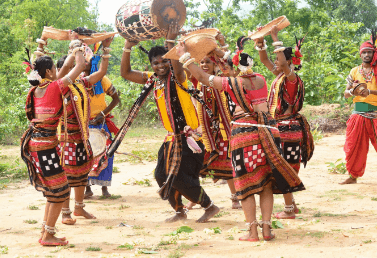
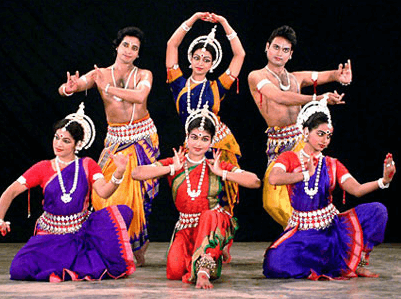
Through state programs and academies, Odisha continues to nurture and showcase its dance heritage, ensuring these traditional dances of Indian states stay relevant for generations.
Kerala – Kathakali & Theyyam
The lush green state of Kerala is a treasure trove of ancient dance forms. Among the most visually striking traditional dances of Indian states are Kathakali and Theyyam, both rooted deeply in the spiritual and ritualistic life of Kerala.
Kathakali is a classical dance-drama that combines dance, music, and elaborate costumes to narrate epic stories from the Ramayana and Mahabharata. Performed mostly by men, it is famous for its vibrant facial makeup, dramatic expressions (abhinaya), and synchronized movements.
Theyyam, a folk ritual from North Kerala, blends dance, mime, and music. Performed in village shrines, it involves elaborate headgear, face painting, and fire walking. Dancers are believed to embody gods during the performance, making it a spiritually charged experience.
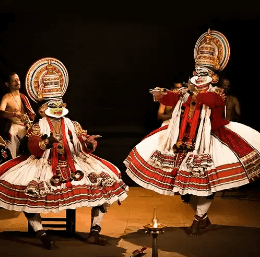
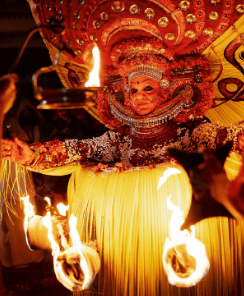
Both forms are preserved through temple festivals and dedicated schools, representing Kerala’s timeless contribution to the traditional dances of Indian states.
West Bengal – Gaudiya Nritya & Chhau
West Bengal’s cultural richness is expressed through diverse dance forms that span classical, folk, and martial traditions. Among the traditional dances of Indian states, Gaudiya Nritya and Chhau showcase Bengal’s historic depth and creative spirit.
Gaudiya Nritya is a classical dance form revived from ancient texts and temple practices. It integrates dramatic storytelling, devotional expressions, and elegant footwork, mainly performed by women.
Chhau, particularly the Purulia style, is a semi-classical tribal martial dance. It involves vigorous movements, stylized combat, and the use of elaborate masks. Themes often come from epics like the Mahabharata and Ramayana.
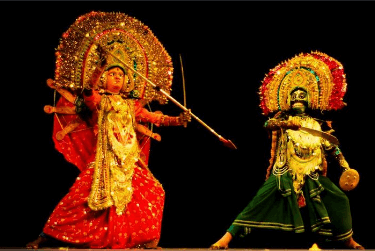
Performed during festivals like Chaitra Parva and local melas, both dances are celebrated for preserving regional identity. Dance academies and state support ensure these traditional dances of Indian states continue to thrive.
Rajasthan – Ghoomar & Kalbelia
The deserts of Rajasthan reverberate with the swirling colors and rhythmic beats of its folk dances. Ghoomar and Kalbelia are two prominent traditional dances of Indian states that highlight Rajasthan’s royal and nomadic heritage.
Ghoomar, once performed by royal women, involves graceful pirouettes and flowing movements. Dancers wear vibrant ghagras and veil their faces, twirling in synchronized patterns to traditional Rajasthani music.

Kalbelia is performed by the Kalbelia community, known for snake charming. The dance mimics serpent-like movements and is performed by women in black swirling skirts with silver embellishments.
Both dances are integral to local fairs and festivals like Teej and Gangaur, representing the state’s resilience, artistry, and tradition.
Manipur – Manipuri Dance
Tucked in the serene hills of Northeast India, Manipur is a cultural treasure trove and the birthplace of Manipuri, one of the most graceful traditional dances of Indian states. With origins deeply rooted in Vaishnavism, this classical dance form evolved from ancient temple rituals and devotional practices, especially those dedicated to Lord Krishna and Radha.
Unlike other classical styles that emphasize sharp movements or dramatic storytelling, Manipuri is all about serenity, fluidity, and inner devotion. The dance is characterized by soft, rounded movements, gentle hand gestures, and expressive eye work that evoke deep spiritual emotions. Female dancers typically wear the iconic Potloi — a beautifully embroidered cylindrical skirt that flows as gracefully as the movements themselves. Male dancers, on the other hand, often bring rhythm, percussion, and dynamic energy to the stage, especially during the vigorous Pung Cholom drum performances.
Manipuri dance is performed during key festivals like Janmashtami, Rasa Lila, and other religious celebrations, where it tells divine tales of Krishna’s childhood, love, and leelas. It is not just a dance — it’s an offering, a meditation in motion.

This traditional dance of Manipur plays a vital role in preserving the state’s spiritual and cultural identity. Institutions like the Jawaharlal Nehru Manipur Dance Academy and state cultural bodies actively promote training and research in Manipuri dance, ensuring that it continues to thrive in modern times.
Today, Manipuri has earned global recognition for its purity, elegance, and spiritual depth. As one of the major traditional dances of Indian states, it beautifully bridges the past and present — preserving heritage while enchanting new generations of audiences around the world.
Andhra Pradesh – Kuchipudi & Dhimsa
Andhra Pradesh offers both classical elegance and tribal zest through its traditional dances. Kuchipudi, a classical form, and Dhimsa, a tribal folk dance, reflect the diversity of the region’s art.
Kuchipudi originated as a dance-drama tradition from the village of the same name. Known for its dramatic storytelling, rhythmic footwork, and expressive gestures, it’s performed with devotional themes and traditional Carnatic music.
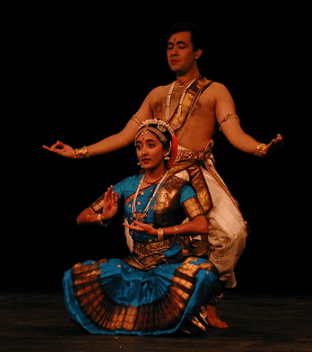
Dhimsa, on the other hand, is performed by tribal communities in the Araku Valley. Women form circles, dancing barefoot to folk instruments during harvests and weddings.
These traditional dances of Indian states are promoted through festivals, educational programs, and cultural centers across Andhra Pradesh.
Maharashtra – Lavani & Koli
Maharashtra, a blend of urban buzz and rural heartland, showcases its culture through dances like Lavani and Koli — vivid examples of traditional dances of Indian states.
Lavani, known for its bold rhythm and powerful expressions, is performed by women to the beats of the dholki. With strong lyrics and vibrant sarees, Lavani blends entertainment with social commentary.
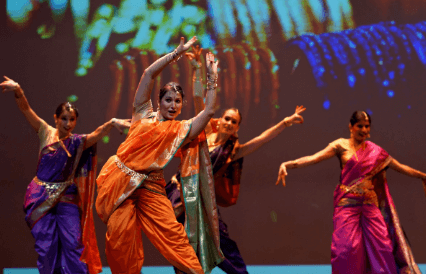
Koli reflects the life of the Koli fishing community. With gestures mimicking rowing and net casting, dancers recreate seafaring scenes, wearing colorful traditional attire.
Both are performed during cultural gatherings and festivals like Ganesh Chaturthi, keeping Maharashtra’s dance heritage alive and dynamic.
Assam – Sattriya & Bihu
Nestled in the lush landscapes of Northeast India, Assam offers a beautiful duality when it comes to the traditional dances of Indian states — one rooted in spiritual devotion, the other in seasonal celebration. These two iconic styles, Sattriya and Bihu, capture the essence of Assamese heritage in graceful and energetic ways.
Sattriya, one of India’s eight recognized classical dance forms, emerged in the 15th century from the Vaishnavite monasteries known as sattras, founded by saint-scholar Srimanta Sankardev. This dance form is deeply devotional, focusing on Bhakti movement themes, especially the life and teachings of Lord Krishna. It blends storytelling, intricate hand gestures, and fluid movements to create a spiritually charged performance. Traditionally performed by male monks, it is now practiced widely by both genders and taught in prestigious institutions.
In contrast, Bihu is a vibrant folk dance performed during the Rongali Bihu festival, which marks the Assamese New Year and the arrival of spring. Young men and women in bright mekhela chadors and dhotis dance in rhythmic sync, accompanied by traditional instruments like the dhol, pepa, and gogona. The movements are lively and flirtatious, celebrating love, harvest, and community spirit.
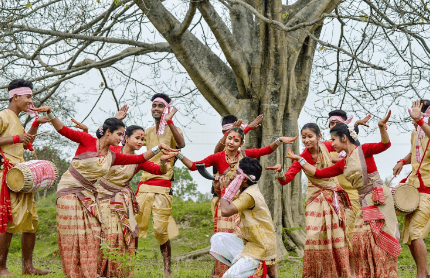
Both Sattriya and Bihu represent the cultural spectrum of Assam — from divine introspection to joyful expression. These traditional dances of Indian states are preserved and promoted through community efforts, government support, cultural academies, and media.
Whether performed in temples, auditoriums, or open fields, the dances of Assam continue to thrive, bridging generations and showcasing the region’s vibrant soul to the world.
Traditional Dances of Indian States – Quick Reference Table
| State | Classical Dance | Folk/Tribal Dance |
|---|---|---|
| Tamil Nadu | Bharatanatyam | Karagattam |
| Punjab | — | Bhangra, Giddha |
| Odisha | Odissi | Dalkhai |
| Kerala | Kathakali | Theyyam |
| West Bengal | Gaudiya Nritya | Chhau |
| Rajasthan | — | Ghoomar, Kalbelia |
| Manipur | Manipuri Dance | — |
| Andhra Pradesh | Kuchipudi | Dhimsa |
| Maharashtra | — | Lavani, Koli Dance |
| Assam | Sattriya | Bihu |
Conclusion: Dancing Through India’s Living Heritage
The traditional dances of Indian states are more than just performances — they are expressions of collective memory, cultural identity, and historical continuity. From the deeply spiritual gestures of Bharatanatyam in Tamil Nadu to the spirited leaps of Bihu in Assam, every region in India tells its story through rhythm, movement, and music.
What makes the traditional dances of Indian states so unique is their diversity and rootedness in local customs. These dances reflect the values, beliefs, and aspirations of the communities they come from — whether it’s the devotional depth of Odissi, the festive energy of Bhangra, or the ritualistic grandeur of Kathakali. Instruments, attire, and even the occasions on which they are performed vary from state to state, making each dance form a visual and emotional journey into the heart of Indian tradition.
However, in the face of rapid modernization, some of these ancient art forms face challenges of preservation. Yet, there’s hope. Government institutions, cultural festivals, and digital platforms are helping revive interest among youth and global audiences. Schools and academies across India are reintroducing these dances as part of formal education and cultural programming.
Understanding and appreciating the traditional dances of Indian states isn’t just about enjoying art — it’s about connecting with India’s roots. These dances carry forward oral histories, regional legends, and sacred rituals, ensuring that India’s intangible cultural heritage is celebrated, safeguarded, and passed on.
So, whether you’re a student, a traveler, or a culture lover, take a moment to explore these mesmerizing dance traditions. Attend a local performance, learn about the costume symbolism, or even take a beginner class — and you’ll find yourself not just watching history, but becoming a part of it.
Let the rhythm of India’s traditions inspire you — because when India dances, it tells the story of its soul.
MCQ QUESTIONS WITH EXPLANATION
1. Which classical dance from Tamil Nadu is known for its sculpturesque poses and devotional themes?
A) Kathak
B) Bharatanatyam ✅
C) Manipuri
D) Odissi
📝 Explanation: Bharatanatyam is a classical dance form from Tamil Nadu characterized by expressive hand gestures, intricate footwork, and spiritual storytelling.
2. Bhangra and Giddha are vibrant folk dances originating from which Indian state?
A) Rajasthan
B) Punjab ✅
C) Gujarat
D) Haryana
📝 Explanation: Bhangra (by men) and Giddha (by women) are joyful harvest dances of Punjab.
3. Which classical dance from Odisha often features tribhangi (three bends) in the posture?
A) Kathak
B) Kuchipudi
C) Odissi ✅
D) Sattriya
📝 Explanation: Odissi is known for its fluidity, grace, and distinctive tribhangi stance.
4. Kathakali is a classical dance-drama famous for:
A) Quick footwork and spins
B) Facial makeup and storytelling ✅
C) Minimal expression
D) Martial techniques
📝 Explanation: Kathakali is visually rich, using elaborate makeup and facial expressions to tell mythological stories.
5. Chhau from West Bengal combines:
A) Sword-fighting and storytelling ✅
B) Singing and dancing
C) Classical poetry
D) Puppetry
📝 Explanation: Chhau is a martial dance form that uses masks and choreography inspired by battles and epics.
6. Which Rajasthani folk dance is performed by women twirling in long skirts?
A) Kalbelia
B) Ghoomar ✅
C) Dalkhai
D) Lavani
📝 Explanation: Ghoomar is a traditional dance by Rajasthani women, known for swirling movements in graceful attire.
7. Manipuri dance is deeply connected to:
A) Harvest rituals
B) Monsoon worship
C) Vaishnavism and Radha-Krishna devotion ✅
D) Buddhist chants
📝 Explanation: Manipuri dance expresses themes of Lord Krishna’s life, using subtle, flowing movements.
8. Kuchipudi, the classical dance from Andhra Pradesh, often includes:
A) Sword balancing
B) Dance dramas on brass plates ✅
C) Martial arts
D) Group chanting
📝 Explanation: In Kuchipudi, dancers sometimes balance on brass plates while performing rhythmic sequences.
9. Which folk dance of Maharashtra is inspired by fishermen and coastal life?
A) Lavani
B) Dhimsa
C) Koli ✅
D) Kalbelia
📝 Explanation: Koli dance reflects the lifestyle of Maharashtra’s Koli fishing community.
10. Sattriya, a classical dance of Assam, was introduced by:
A) Raja Ravi Varma
B) Guru Sankardev ✅
C) Rukmini Devi
D) Saint Kabir
📝 Explanation: Sattriya was created by Vaishnavite saint Sankardev as part of Assam’s religious rituals in monasteries.

